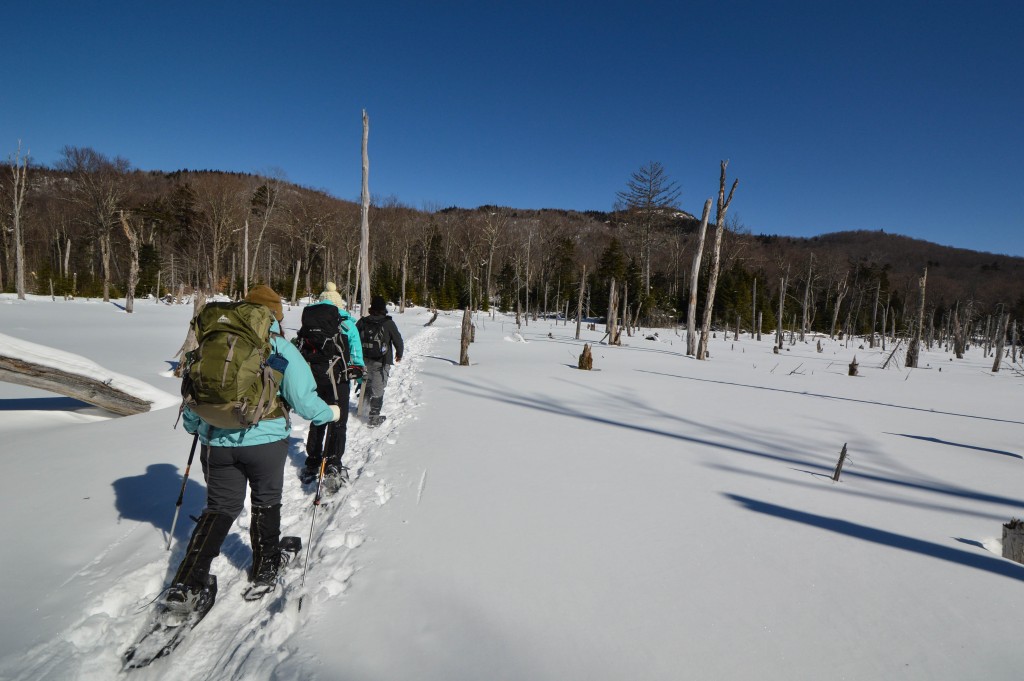Winter Hiking: Essential Considerations, Part Two
Winter Hiking: Essential Considerations, Part Two
By Noah Haber, High Peaks Information Center Assistant Manager
Last week, I shared three essential considerations for winter hiking, which covered advanced planning and layering systems. Winter is a beautiful time of year to recreate, but with cold weather comes greater risks, so it is important to prepare in advance for numerous scenarios to ensure that you have a safe and enjoyable backcountry experience. Here are three more questions to ask yourself before hitting the trail this winter.
Do I have enough food and water?
An active layering system is key to staying warm and dry, but you also need to give your body fuel and drink water to continuously generate heat. Because of the cold, recreating in the winter is more of a caloric challenge than in the warmer months. Your body is expending more energy to maintain your internal temperature. This means you need to eat a lot more in the winter and remember to drink lots of water.
If you’re out for a whole day of hiking over strenuous terrain during the winter, you should intake roughly 5,000 – 6,000 calories throughout the day. To achieve this, you need to have lot of quick snacks and meals that are easy to eat in low temperatures. Something like a Snickers bar, for example, might freeze solid in the winter and be pretty rough on your teeth, though softer kinds of candy can offer that quick fix that will help you maintain your energy levels. You also don’t want to have to spend a long time stationary preparing meals so the less preparation the better. I recommend bringing a thermos full of soup, or a backpacking stove to make a quick warm meal with high calories, like instant mashed potatoes or pasta.
Additionally, remember to take short, frequent breaks to rehydrate. I recommend bringing two liters in wide-mouthed Nalgene bottles. Pour hot water into your bottles so it doesn’t freeze, and insulate it using a wool sock or a manufactured water bottle insulating sleeve. If you’re going out for a longer hike, use a pot or kettle on your camp stove to melt snow for drinking water if needed.
Do we have Microspikes and snowshoes?
Snowshoes are an essential piece of gear for winter hiking for multiple reasons. First off, they provide flotation in deep snow, which makes hiking in the winter less strenuous and much safer. Additionally, by evenly compacting snow—as opposed to punching holes with your feet—snowshoes keep other recreators safe. Postholes, which are icy holes left by boots that have punched through deep snow, can cause substantial injury to skiers if their skis catch in a deep, icy hole in the trail. Be aware that some areas require snowshoes if there is a certain snow depth. This includes the High Peaks Wilderness, which requires them to be worn if there is more than 8 inches of off-trail snow.

Additionally, if you’re going to higher elevations, especially into the alpine zone above the tree line, you will need Microspikes to tackle steep and icy surfaces. By giving you better traction, Microspikes will allow you to stay in the center of trail while avoiding dangerous falls. This is particularly important in the alpine zone, where sensitive and ecologically vital alpine vegetation can be easily killed by trampling. Although there is snow and ice cover, these delicate plants are still vulnerable and, without sufficient traction, hikers often step off the side of the trail to avoid a dangerous slip, which can crush these rare species.
Don’t own either of these items? That’s okay! Many outdoor outfitters and retailers rent them out for single and multi-day trips, including our High Peaks Information Center.
Are we prepared if our gear fails or in the event of an emergency?
One of the last aspects I would like to discuss is the concept of redundancy. While it’s important to have the ten essential items any time of year, during the winter it’s important that you not only have all those essentials but also extras in case something happens. This means carrying an extra headlamp and batteries, extra gloves and hat, extra layers, extra food, and so forth.
Though it adds weight to your pack, it could also save your life. If something happens that causes you and your group to be out longer than anticipated, these extra supplies will keep you fed, hydrated, and protected while you work through that situation. Additionally, between extreme cold and weather conditions, gear is bound to fail, so having backups will keep you and others out of harm’s way.
In closing, this two-part article provides a good starting point for those who are interested in getting outside safely and responsibly during the winter. Recreating during this time of year is a sensational experience but respecting the harsh and variable conditions of this season and the dangers they can present are crucial to ensuring the safety and success of your outdoor adventure.
If this is your first time, take it slow. Visit some small peaks or familiar ponds so that you get the chance to experience winter conditions in a safer setting. As you accumulate experience and the necessary items, work your way towards bigger goals. And, remember you can always reach out to us other outdoor organizations for advice. You can reach our High Peaks Information Center staff via ADK’s social media Facebook and Instagram accounts, by phone at 518-523-3441 ext. 121, or by email at hpic@adk.org for advice on hiking or recreating in the High Peaks Region of the Adirondacks.
ADK also offers in-person and online winter outdoor skills programs, which you can learn more about here.

Related
Mud Season: Quick Facts
Just what is mud season? Running anytime from late March into mid-June—it varies each year […]
Spring on the NPT
by Jeffrey Case In the Spring a fuller crimson comes upon the robin’s breast; In the […]
Impromptu Honeymoon on the NPT
by Addison Wolanin My wife, Shannon, and I got married in July 2020—and we all […]
ADK’s Visitor Centers Provide Critical Services
February 7, 2024 — Lake Placid, NY — Data from two Adirondack Park visitor centers […]

